These Kitchen Plants Clean Your Air While You Cook

Your kitchen might smell amazing, but it’s also home to hidden airborne toxins — from cooking fumes, cleaning sprays, and lingering grease. The good news? Certain houseplants do more than look good — they actually help purify the air by absorbing chemicals and producing clean oxygen. And many of them thrive in kitchen conditions like humidity, warmth, and indirect light.
Here are the top toxin-filtering plants that bring both function and freshness to your kitchen.
Table of Contents
Spider Plant (Chlorophytum comosum)
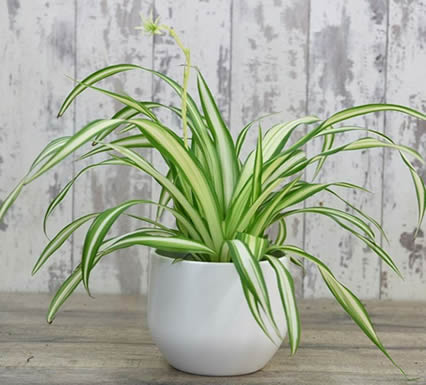
-
💡 Light: Low to bright, indirect light
-
💧 Water: Water when top inch of soil dries
-
🌫️ Humidity: Enjoys kitchen humidity
-
🌡️ Temperature: 13–27°C / 55–80°F
-
🌱 Soil: Light, well-draining mix
-
🧪 Fertilizer: Monthly during growth season
-
🐾 Pet-Friendly: Yes
Aesthetic: Fountain-like leaves with green and white stripes — plus baby offshoots that hang down like little comets.
Air Benefit: Excellent at removing formaldehyde, carbon monoxide, and xylene — all common in household air.
Care Summary: Very forgiving and low-maintenance.
Great on shelves or in hanging planters near windows or stoves.
For a more detailed care guide see Spider Plant Care: How to Grow a Happy, Trailing Houseplant.
Snake Plant (Sansevieria trifasciata)
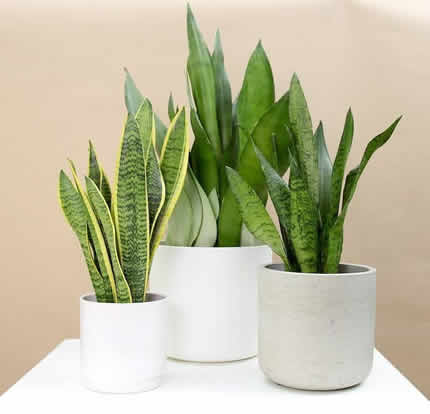
-
💡 Light: Low to bright, indirect light
-
💧 Water: Every 2–4 weeks
-
🌫️ Humidity: Tolerates all levels
-
🌡️ Temperature: 15–29°C / 60–85°F
-
🌱 Soil: Succulent or cactus mix
-
🧪 Fertilizer: Light feeding every 2 months
-
🐾 Pet-Friendly: No
Aesthetic: Upright, sword-like leaves with bold patterns. Adds vertical height and structure to corners or countertop spaces.
Air Benefit: Filters formaldehyde, benzene, and nitrogen dioxide. Known for oxygen production — even at night.
Care Summary: One of the easiest plants to grow.
Thrives in dim kitchens and tolerates occasional neglect.
For a more detailed care guide see Snake Plant Care Made Easy.
Aloe Vera (Aloe barbadensis) & other Aloe Varieties
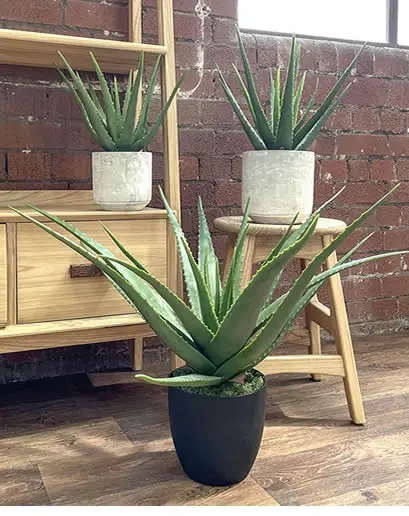
-
💡 Light: Bright, indirect sunlight
-
💧 Water: Every 2–3 weeks
-
🌫️ Humidity: Prefers drier air but adapts
-
🌡️ Temperature: 18–26°C / 65–80°F
-
🌱 Soil: Cactus/succulent blend
-
🧪 Fertilizer: Optional every 2–3 months
-
🐾 Pet-Friendly: No
Aesthetic: Thick, spiky green leaves with gel inside — functional and sculptural at once.
Air Benefit: Removes formaldehyde and benzene. Bonus: use the gel for minor kitchen burns or skin soothing.
Care Summary: Loves sunny kitchen windows.
Water deeply but infrequently.
Use a breathable pot like terra cotta.
For a more detailed care guide see Aloe Plant Care Basics For A Healthy Vibrant Succulent.
Peace Lily (Spathiphyllum spp.)
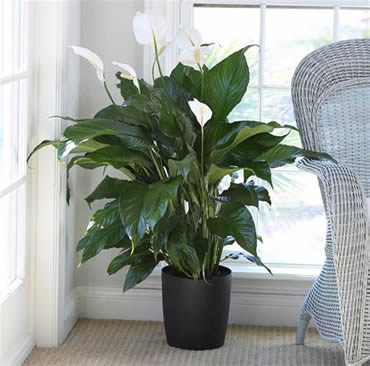
-
💡 Light: Low to medium, indirect light
-
💧 Water: Keep soil slightly moist
-
🌫️ Humidity: Loves humidity
-
🌡️ Temperature: 18–26°C / 65–80°F
-
🌱 Soil: Rich, well-draining mix
-
🧪 Fertilizer: Monthly in spring/summer
-
🐾 Pet-Friendly: No
Aesthetic: Elegant white blooms rise above glossy green foliage — clean and calming for minimalist kitchens.
Air Benefit: NASA-tested for filtering ammonia, benzene, and trichloroethylene.
Care Summary: Thrives in moist, humid spaces like near sinks.
Mist often and don’t let it dry out completely.
For a more detailed care guide see Peace Lily Care: How to Grow a Lush, Flowering Plant That Cleans the Air.
English Ivy (Hedera helix)
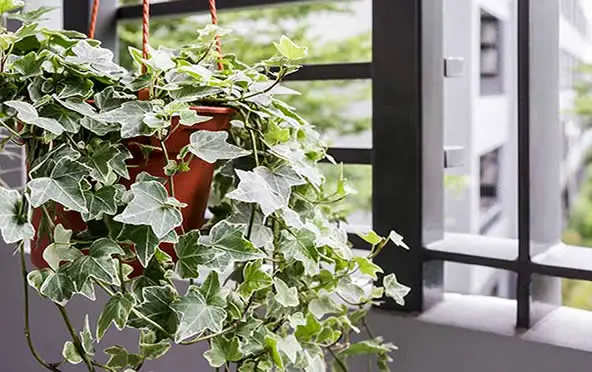
-
💡 Light: Low to medium, indirect light
-
💧 Water: Keep soil lightly moist
-
🌫️ Humidity: Likes humidity and airflow
-
🌡️ Temperature: 10–22°C / 50–72°F
-
🌱 Soil: Moist, well-draining mix
-
🧪 Fertilizer: Monthly during active growth
-
🐾 Pet-Friendly: No
Aesthetic: Cascading vines with classic ivy leaves — great for top shelves or hanging baskets near kitchen windows.
Air Benefit: Removes airborne mold spores and fecal particles — excellent for kitchens near bathrooms or garbage areas.
Care Summary: Likes cooler spots with consistent moisture.
Needs good air circulation.
For a more detailed care guide see English Ivy Care: How to Grow a Classic, Trailing Plant Indoors or Out.
Bamboo Palm (Chamaedorea seifrizii)

-
💡 Light: Medium, indirect light
-
💧 Water: Water when top inch of soil dries
-
🌫️ Humidity: Prefers high humidity
-
🌡️ Temperature: 18–27°C / 65–80°F
-
🌱 Soil: Rich, moist, well-draining mix
-
🧪 Fertilizer: Every 2 months during growth
-
🐾 Pet-Friendly: Yes
Aesthetic: Tall, airy fronds give a tropical, open feel — ideal for bright corners of spacious kitchens.
Air Benefit: Effective at removing formaldehyde and airborne toxins from furniture or flooring.
Care Summary: Requires consistent moisture and warmth.
Keep away from cold drafts or dry heat.
For a more detailed care guide see Bamboo Palm Care: The Air-Purifying Palm That Thrives Indoors.
Pothos (Epipremnum aureum)
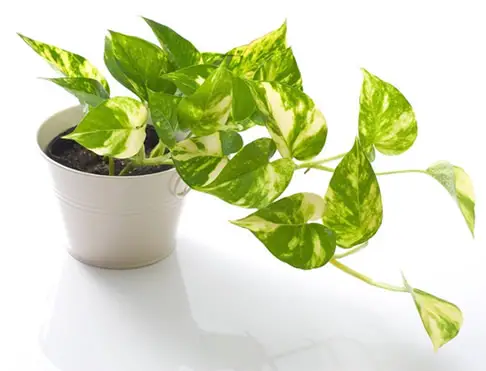
-
💡 Light: Low to bright, indirect light
-
💧 Water: Let top inch dry before watering
-
🌫️ Humidity: Adapts to most levels
-
🌡️ Temperature: 18–30°C / 65–85°F
-
🌱 Soil: All-purpose houseplant mix
-
🧪 Fertilizer: Monthly in spring and summer
-
🐾 Pet-Friendly: No
Aesthetic: Cascading vines with marbled or solid green heart-shaped leaves — great on shelves or above cabinets.
Air Benefit: Filters formaldehyde, toluene, and benzene. One of the best beginner-friendly air purifiers.
Care Summary: Incredibly low-maintenance. Avoid soggy soil.
Prune to control shape and growth.
For a more detailed care guide see Golden Pothos Care: A Trailing Favorite That’s Almost Impossible to Kill.
Fittonia (Fittonia albivenis)
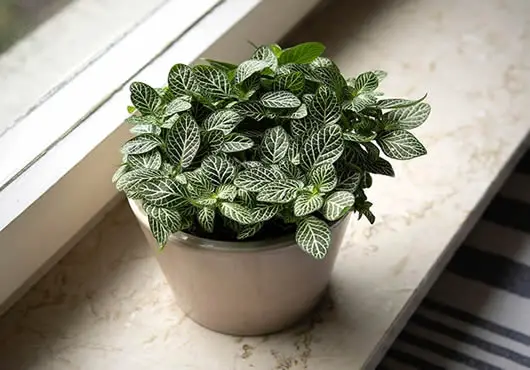
-
💡 Light: Low to medium, indirect light
-
💧 Water: Keep soil consistently moist
-
🌫️ Humidity: Needs high humidity
-
🌡️ Temperature: 18–24°C / 65–75°F
-
🌱 Soil: Peat-rich, well-draining mix
-
🧪 Fertilizer: Monthly during active growth
-
🐾 Pet-Friendly: Yes
Aesthetic: Vivid leaf veining in pink, white, or red — tiny but bold.
Air Benefit: While not the strongest purifier, Fittonia improves oxygen and adds lush texture to enclosed kitchens.
Care Summary: Thrives in humid spaces like near the sink.
Water frequently and keep in indirect light.
For a more detailed care guide see Nerve Plant Care: How to Keep Fittonia Thriving With Color and Flair.
Final Word
A healthier home doesn’t always come from high-tech gadgets. These air-purifying kitchen plants are natural allies — removing toxins, releasing oxygen, and adding beauty to your space.
With the right mix of light, water, and placement, your kitchen can become a cleaner, greener zone that supports both your food and your well-being.
Thanks for reading! I'm Michael — houseplant fanatic and your Pinterest plant guide.
Follow me on Pinterest for fresh updates 🌿



